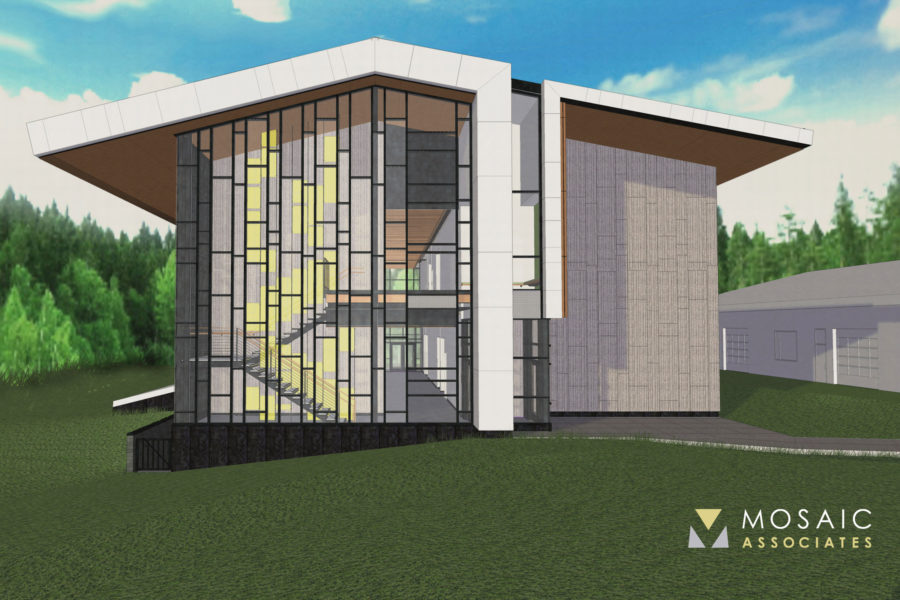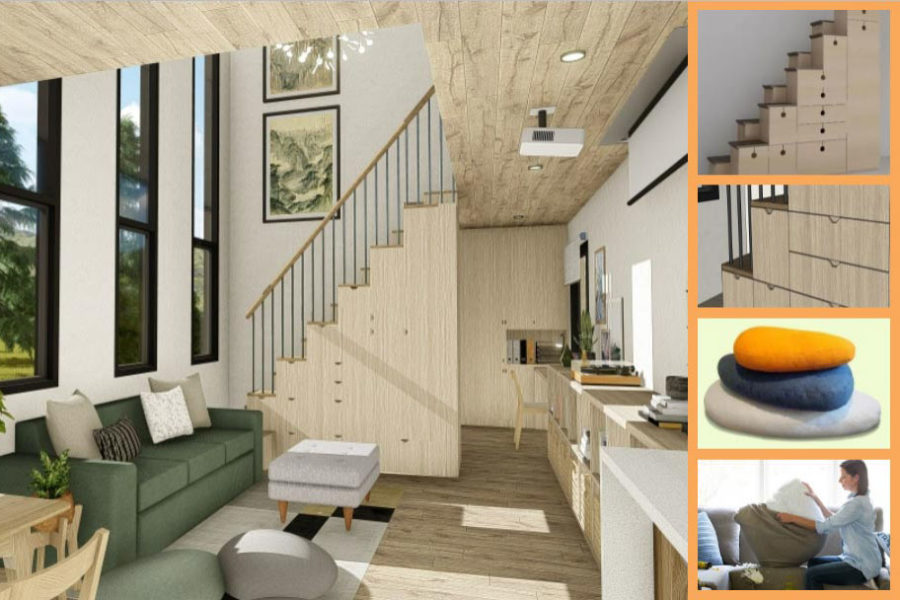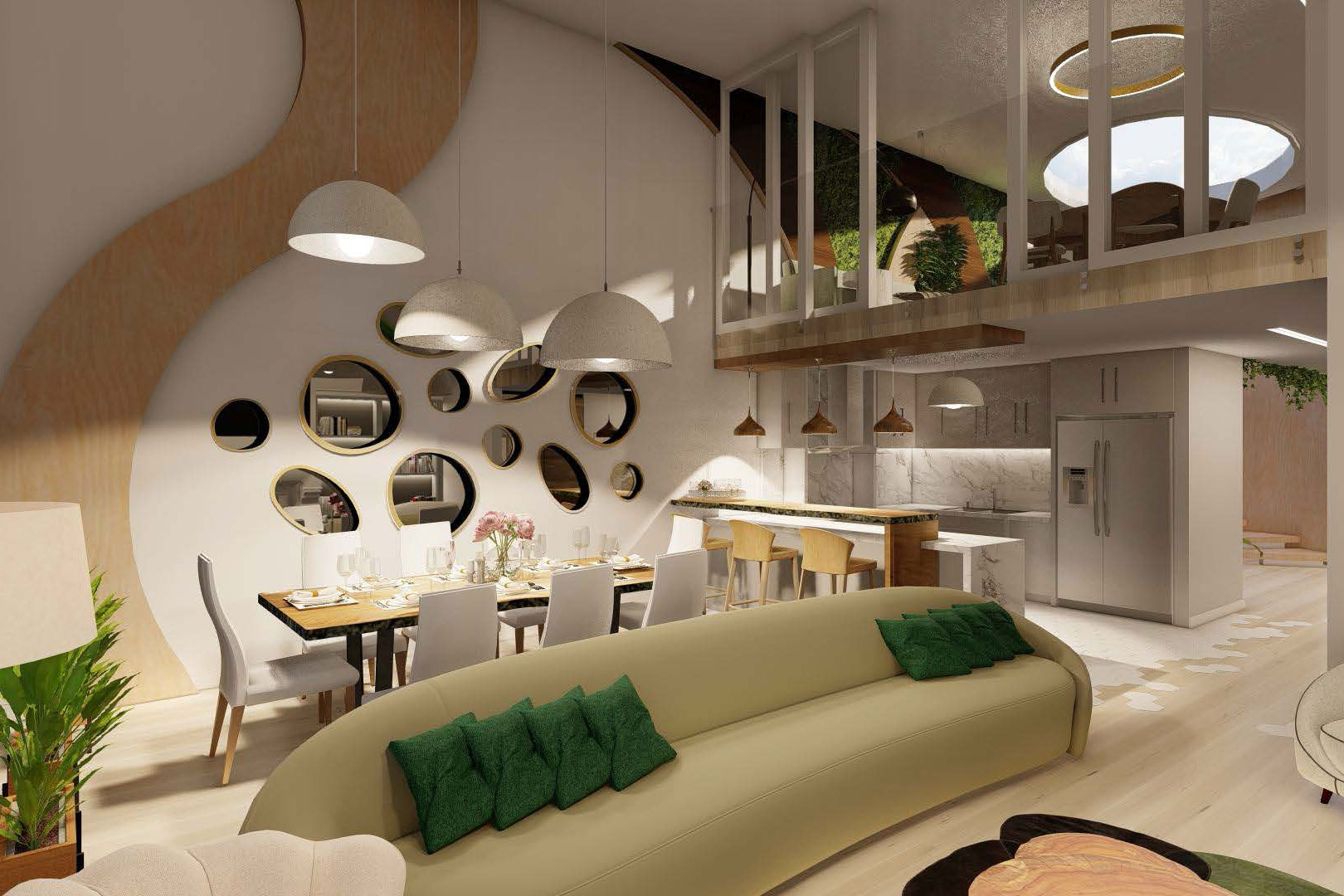Story at a glance:
- NYSID’s Seema Lisa Pandya teaches as part of the Master of Professional Studies in Sustainable Interior Environments program.
- The professor combines her passion for sustainability, design, and art as part of her teaching.
- Students are taking lessons from NYSID into the real world, from material choices to supporting women- and POC-owned businesses.
Seema Lisa Pandya has been in the green building industry for more than 15 years. She’s a sustainability consultant, professor, LEED reviewer, and also a fine artist. As part of the Sustainable Interior Environments graduate program at The New York School of Interior Design (NYSID), Pandya takes her wide breadth of knowledge and passion for sustainable design into the classroom.
NYSID’s Master of Professional Studies in Sustainable Interior Environments is a post-professional program that prepares design professionals to become leaders in developing and maintaining sustainable interior spaces that positively affect the world. Pandya’s teaching extends even beyond interiors, though.
“I don’t want to just limit it to interiors. I want my students to get a deeper understanding of how they connect to a bigger ecosystem and even professional ecosystem of the built environment,” she says. “We look at materials, water, indoor air quality, sites, equity, and more. We bring up climate science, but we know so much about the doom and gloom, it’s better to focus on the solutions we know are within our control. I’ve seen my students really thrive and take this into their careers.”

NYSID’s Seema Lisa Pandya teaches as part of the Master’s in Sustainable Interior Environments post-professional program.
Pandya says lessons are also moving away from “how to design for the 1%” and looking at a lot more varied scenarios—from a tiny house in a tiny house community to cohousing and multigenerational housing in rural and urban settings. “One of our briefs talks about designing a retreat center in New Mexico that’s mainly for Native American youth group’s use,” she says. “There’s a lot of cultural sensitivity that has to go into this. How do you engage on that level without culturally appropriating? We ask students, ‘What can you do to embody and support the current community?’ There are a lot of interesting questions coming out of this.”
We recently sat down with Pandya to explore more about how sustainability, design, and art intersect, the enthusiasm of today’s students, and where she sees the industry going.
Let’s start in the classroom. What does it mean to teach sustainable design?
We’re looking at more focus on wellness, mental health, and physical health. We’re looking at more conversations and design solutions around equity. There is also more conversation around professional practice and how do you incorporate sustainable ethics into your practice in general. We’re looking at the effect of beauty in terms of communicating sustainability.
What does beauty in sustainability mean?

Seema is providing sustainable building consulting through d2d Green Design for a current SUNY Hudson Valley Community College project. Rendering courtesy of Mosaic Architecture
There was an article in The Guardian many years ago that piqued my interest. It essentially said that beauty, not spreadsheets, can evoke an emotional connection to nature and effect change that’s needed for climate change. That really struck me as an idea, especially as an artist. Essentially what that’s saying is that if we look at the problem on a bigger scale, it’s really about the fact that we are disconnected from nature as a society. Society is designed to be disconnected from “Where does our food come from?” “Where do our materials come from?”
The best way for us to connect is emotionally. The best way in my mind to get that emotional connection is through things that evoke beauty and artistic dialogue. For example, is it enough to just specify low-flow fixtures for a building, or are we really trying to create a design that, yes, saves water, but maybe we take it a step further and design it in such a beautiful or even educational way that people start to care and learn about the earth’s water cycle. That opens up a whole other realm of possibility—messaging and storytelling through something that will evoke an emotional response.
How do you personally weave art into, say, a sustainable interior design project?

NYSID Professor Seema Lisa Pandya designed and fabricated the Amoebic Bench (2020) for Brockport College. The bench is made from thick wood slabs from felled trees salvaged from a nearby construction site. Photo by Seema Lisa Pandya
When you’re an artist, you just are at birth. I try to balance it with all this other work I do, but over the last six years I really pushed into wanting to produce a lot more artistic work. My path is leading me toward working more in the public art realm, where I can do more to directly integrate sustainability and art into the built environment. For example, one of the artistic public projects on my drawing board is a sculpture that would harvest rainwater and drip a little percussive symphony every time it rains.
How has the pandemic changed conversations around sustainability?
We’re seeing it more because of the pandemic. Even before Covid the USGBC shared the statistic that we spend 90% of our time indoors. Now we’re seeing even more just how much interiors and our built environment affect our mental and emotional health.
I’m seeing a larger emphasis on things like exploring biophilia, and it goes a lot deeper than “I’m going to put a bunch of plants in here.” At NYSID the students reference the 14 Patterns of Biophilic Design by Terrapin Bright Green, and with that we’re not just looking at nature in terms of plants; we’re looking at it in terms of: Are we designing for neurodiversity, in that people can take prospect and refuge in places? Are there spaces that are more open? Do we have places of retreat? Do we have a variety of ranges of daylight or options for natural ventilation or sound quality? There are all these things that entice our senses from nature’s point of view.
On the wellness side, another theme I’m teaching is active design. The students reference the Active Design Guidelines put out by the NYC Department of Design and Construction to design based on what effect our built environment has on our physical health. Can we design so stairs are more appealing and we’re using our physical body more? As the CDC says, “Sitting is the next smoking.” Active design is something we are teaching at NYSID and also seeing in the workplace more and more.
There’s also a great emphasis on indoor air quality and toxicity, using things like the WELL rating system and Living Building Challenge, Red List, and so many other resources out there. I remember when I was in school the choices were few and far between. Now there are so many tools at designers’ and architects’ fingertips; there’s no excuse for not addressing these things. Our clients are becoming more and more savvy, and if we aren’t designing sustainably, we are basically outdated.
What effect does a designer’s decisions have on the industry as a whole?

Tiny House in Co-Housing Intentional Community designed by NYSID students Paulina Francisco and Grace Spiezia as part of Fall 2021 coursework. Image courtesy of Seema Lisa Pandya
We have a lot of discussions, and part of those ask: Can you come up with some principles of what you want in your professional practice—whether or not your clients ask for it? I have a former student, Hilary Tate, who started her business after graduation. One of the things she’s focusing on is really sourcing, as much as she can, products that have strong sustainability ethics and also supporting women- and BIPOC-owned businesses. So it’s like, “OK. As someone in the world who’s spending money for my clients, I can make those types of ethical decisions.”
How is equity a part of sustainable design?
There’s a lot more thought into: How inclusive are our designs? Let’s say you have a very nice restaurant, for example. Are you designing it in a way in which you are just thinking about the front of the house, or are you giving the same treatment to the back of the house? Are you thinking about the wellness of the people who are working there?
Especially during Covid the conversation around wellness has become more apparent as a need in the forefront. When we’re talking about sustainability, we’re working within a capitalist system that is designed to take advantage of certain people. When we think about, for example, toxicity, who is more exposed and vulnerable? It’s frontline workers, children, pregnant women, and people who, for all kinds of capitalist socioeconomic reasons, have been historically regimented to live in redlined communities that are closer to highways, closer to factories because people like minorities and Black Americans were historically not allowed to get loans to buy homes that were not in these redlined communities. So it predisposed them to be more exposed to environmental toxins. The products we specify have an effect in that regard.
There are also equity changes needed even in design nomenclature. Like, real estate associations are asking whether we should get rid of the term master bedroom when that’s a term that is somewhat tied to slavery. Even though we’re not using it in that context, it’s still in the nomenclature, and we have a chance to change that. Then there’s equity in terms of access to fresh air and access to daylight in our built spaces.
How is this education evolving beyond students in the classroom?
NYSID had me create a version of an Introduction to Sustainable Design class that’s more geared for teachers. It’s also geared toward working professionals, but mainly for educators to figure out how sustainability relates to their class subject matter.
NYSID is really working hard to bring sustainability more to the forefront because, sure, you can have a class in sustainability, but what is more effective is to have it integrated into all of the classes. Because sustainability is not a side topic; it does integrate into every aspect of design and life. It’s really exciting that the New York School of Interior Design is making such an effort to address even continuing education in sustainability.

